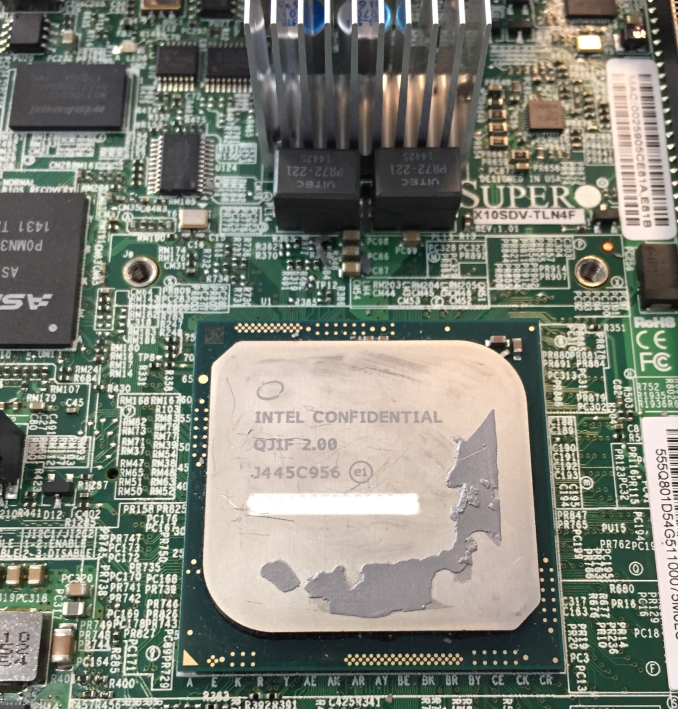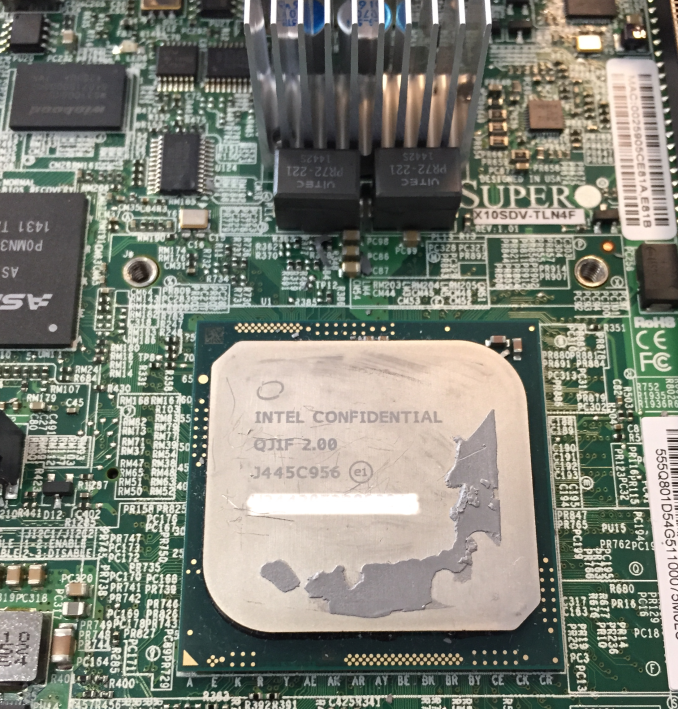The Intel Xeon D Review: Performance Per Watt Server SoC Champion?
by Johan De Gelas on June 23, 2015 8:35 AM EST- Posted in
- CPUs
- Intel
- Xeon-D
- Broadwell-DE

The days that Intel neglected the low end of the server market are over. The most affordable Xeon used to be the Xeon E3: a desktop CPU with a few server features enabled and with a lot of potential limitations unless you could afford the E5 Xeons. The gap, both in performance and price, between Xeon E3 and E5 is huge. For example - a Xeon E5 can address up to 768 GB and the Xeon E3 up to 32 GB. A Xeon E5 server could contain up to 36 cores, whereas Xeon E3 was limited to a paltry four. And the list is long: most RAS features, virtualization features were missing from the E3, along with a much smaller L3-cache. On those terms, the Xeon E3 simply did not feel very "pro".
Luckily, the customers in the ever expanding hyperscale market (Facebook, Amazon, Google, Rackspace and so on) need Xeons at a very large scale and have been demanding a better chip than the Xeon E3. Just a few months ago, the wait was over: Xeon D fills the gap between the Xeon E3 and the Xeon E5. Combining the most advanced 14 nm Broadwell cores, a dual 10 gigabit interface, a PCIe 3.0 root with 24 lanes, USB and SATA controllers in one integrated SoC, the Xeon D has excellent specs on paper for everyone who does not need the core count of the Xeon E5 servers, but who simply needs 'more' than the Xeon E3.
Many news editors could not resist calling the Xeon D a response to the ARM server threat. After all, ARM has repeated more than once that the ambition is to be competitive in the scale-out server market. The term "micro server" is hard to find on the power point slides these days; the "scale-out" market is a lot cooler, larger and more profitable. But the comments of the Facebook engineers can quickly brings us back to reality:
"Introducing "Yosemite": the first open source modular chassis for high-powered microservers"
"We started experimenting with SoCs about two years ago. At that time, the SoC products on the market were mostly lightweight, focusing on small cores and low power. Most of them were less than 30W. Our first approach was to pack up to 36 SoCs into a 2U enclosure, which could become up to 540 SoCs per rack. But that solution didn't work well because the single-thread performance was too low, resulting in higher latency for our web platform. Based on that experiment, we set our sights on higher-power processors while maintaining the modular SoC approach."
It is pretty simple: the whole "low power simple core" philosophy did not work very well in the real scale out (or "high powered micro server") market. And the reality is that the current SoCs with an ARM ISA do not deliver the necessary per core performance: they are still micro server SoCs, at best competing with the Atom C2750. So currently, there is no ARM SoC competition in the scale out market until something better hits the market for these big players.
Two questions remain: how much better is the 2 GHz Xeon D compared to the >3GHz Xeon E3? And is it an interesting alternative to those that do not need the high end Xeon E5?











90 Comments
View All Comments
Kjella - Tuesday, June 23, 2015 - link
Server on a chip? It's not intended for use with a display, it does all it's "supposed to" do for the hyperscale market without any display.close - Tuesday, June 23, 2015 - link
"Intel was able to combine 8 of them together with dual 10 Gbit, 4 USB 3.0 controllers, 6 SATA 3 controller and quite a bit more".This ^^ makes it a SoC. Ok, a video output would be nice but that certainly doesn't disqualify it.
ats - Tuesday, June 23, 2015 - link
cause video isn't required or even wanted in this market segment. It is a SoC, which simply means system on a chip and doesn't have some ironclad definition. Hell, most "SoC" chips aren't really systems on a chip anyways and require significant supporting logic (this is true for just about any cell phone SoC on the market too).bill.rookard - Tuesday, June 23, 2015 - link
Exactly, you would tend to use remote management over the network to admin this type of a unit. I have several rackmounted servers in my basement (I do some home-serving of websites over a business class connection) and while I do have them actually hooked up to a display, I can hardly remember the last time I looked at them as 99.9% of the time I SSH into everything for administration.About the only time you'd ever really use a display is if you were doing multiple VMs of assorted types. Beyond that, it's wattage wasted.
ats - Tuesday, June 23, 2015 - link
Yeah honestly, having several SM boards with their ILM system, the only time I'd ever hook up a display is if the network was down. The SM ILM will fully proxy pretty much anything you want and give you a 1200p display that works for just about anything. And you can remotely hook up CDs, DVDs, BRs, USB, etc through it along with the stand console and keyboard/mouse functions. Its a very nice solution.nightbringer57 - Tuesday, June 23, 2015 - link
Basically, you don't need video output.Even if you do, mainboard manufacturers usually include a third-party chip with dedicated functions that, along other things, provide a VGA port usable for a server use.
In this case, the AST2400 chip offers some basic GPU functions with a VGA port along with many remote control-related stuff.
Adding all those functions to the Intel SoC would be awfully expensive. The chip only requires a simple PCIe x1 connection from the SoC, but provides hundreds of additional pins. Not only would those functions probably be hard to implement on a relatively recent 14nm process, but it would require at least 300 new pins on the SoC to add all the 3rd party chip's functions on it, which is almost impossible to do.
Th-z - Tuesday, June 23, 2015 - link
There doesn't seem to have a concrete definition for the term SoC, but it's ridiculous now with the term SoC bandwagon. Everything seems to be called "SoC" these days as long as a chip has more than one functions integrated. One of examples is people even called current console's integrated CPU and GPU chip as SoC, which doesn't even have networking and other peripheral units in it. When a system has so many "SoCs" inside, the term really has lost its meaning and significance.redzo - Tuesday, June 23, 2015 - link
I'm thinking this is a bad name for a product like this. It reminds of the infamous Celeron D and Pentium D line.nandnandnand - Tuesday, June 23, 2015 - link
Anyone who can figure out Xeon D exists can probably tell the differencewussupi83 - Tuesday, June 23, 2015 - link
I agree with redzo, I think anyone who can figure out a 'Xeon D' exists AND remembers that Pentium & Celeron D's existed would initially assume this is a budget Xeon - which it's clearly not. E4 sounds pretty logical. But sure lets just put D...